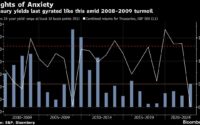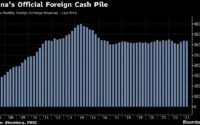Time to Look at Foreign Demand for the Incredibly Ballooning US National Debt
As China unloaded Treasury securities and Japan propped up the yen, other countries loaded up.
By Wolf Richter for WOLF STREET.
Who is buying the ballooning US government debt that has now reached $32.5 trillion? That’s on everyone’s mind. For now, there is way too much demand for long-term Treasury securities, or else the 10-year yield wouldn’t be 3.8%, but 6.8%, and the 30-year yield would be further north. But maybe someday yields will have to rise to lure more buyers. Yield solves all demand issues. If you can’t sell them at 5%, try 5.1%. Just about anything will sell if the yield is high enough. That’s why even junk bonds find eager buyers. But we’re not there yet with Treasuries.
Even foreign buyers are still loading up, particularly in Europe. But China and Japan, the two largest holders of Treasury securities, have been unloading.
In total, all foreign holders held $7.53 trillion in Treasuries in May, down a hair from the record holdings in April, but up by 2.4% from a year ago (red line), according to the Treasury Department’s TIC data today. By contrast, the holdings of China and Hong Kong combined (purple) fell by 6.6% from a year ago, and the holdings of Japan (green) fell by 10.1% from a year ago. Both countries have for years been losing importance among foreign holders of the US debt:
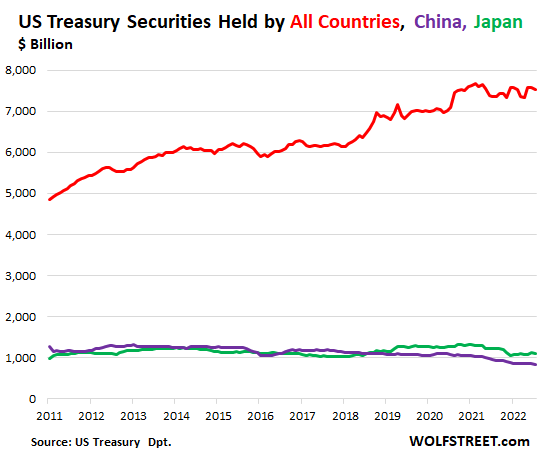
Foreign holders became less crucial. As the US debt has ballooned over the years, but foreign holdings have increased more slowly, the share of foreign holdings as a percent of the total federal debt has declined from the 33% range in 2014 to less than 24% in May. In other words, the US debt financing has become less dependent on foreign holders:
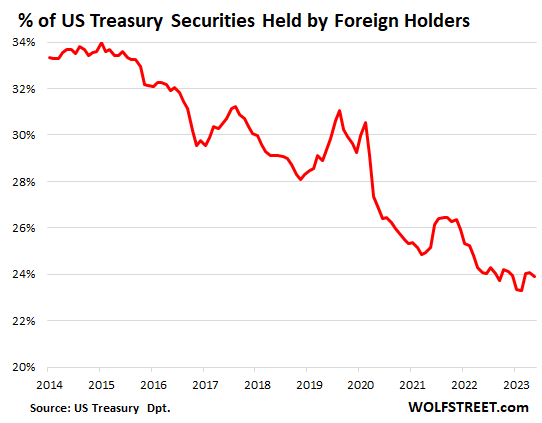
Japan’s Ministry of Finance late last year cashed in some US-dollar assets, presumably Treasury securities, and then blew $68 billion in dollar-cash to buy yen in the foreign exchange market to prop up the yen after it had plunged to ¥150 to the dollar by October.
And we can see that the MoF prepared for propping up the yen in advance. Japan started cashing out in August 2022, and by October, it had unloaded $132 billion in Treasury securities.
Since then, its holdings have zigzagged higher again, and remain in the historical range. In May they dipped to $1.097 trillion, down by 10.1% from a year ago:
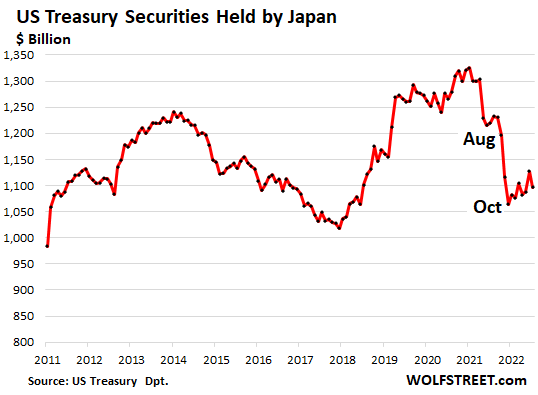
China has been unloading Treasuries for years. In May, its holdings of Treasuries fell to $847 billion, the lowest in the data going back to 2011 (red in the chart below), down by 11.0% from a year ago.
During the capital-flight panic in 2016, China sold Treasury securities to prop up the RMB. It then brought its holdings back to the declining trend. Since Covid, the decline of its holdings has accelerated.
China and Hong Kong can be looked at together (green). Hong Kong’s holdings increased by $30 billion year-over-year (+16.4%), while China’s holdings dropped by $105 billion (-11.0%) year-over-year. Their combined holdings fell by 6.6%, to $1.06 trillion, matching the prior low points in October and February:
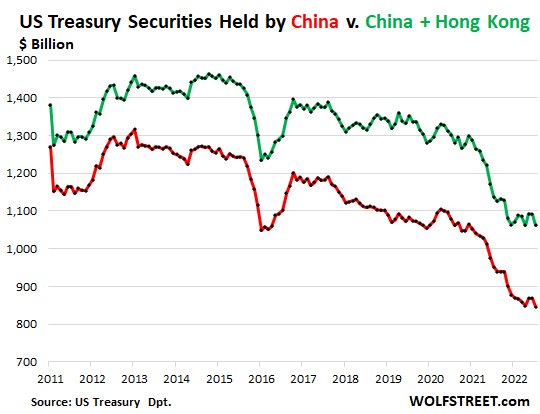
The UK, third largest foreign holder.
The City of London is a global financial center, so this isn’t the UK government or the Bank of England propping up US Treasuries, but it reflects activities of the financial center. Holdings had reached a new record in March, and have dipped for two months to $667 billion in May, up by 4.7% from a year ago:
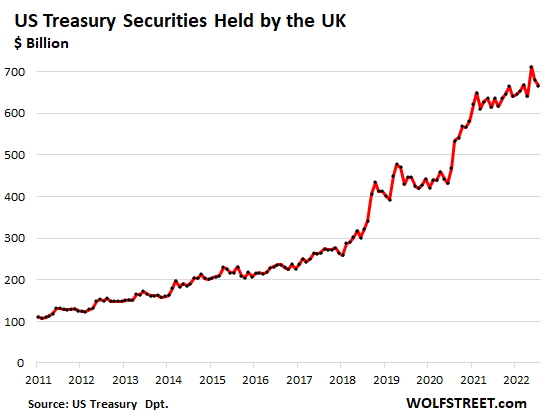
The financial centers. These are tiny countries that specialize in handling and often obscuring the financial holdings of global companies, individuals, and governments. And they have huge holdings of Treasury securities. Ireland is favorite place for US companies to store their profits and wealth:
- Belgium, red, (home of Euroclear): $335.5 billion
- Luxembourg: $334 billion
- Switzerland: $304 billion
- Cayman Islands: $263 billion
- Ireland: $245 billion
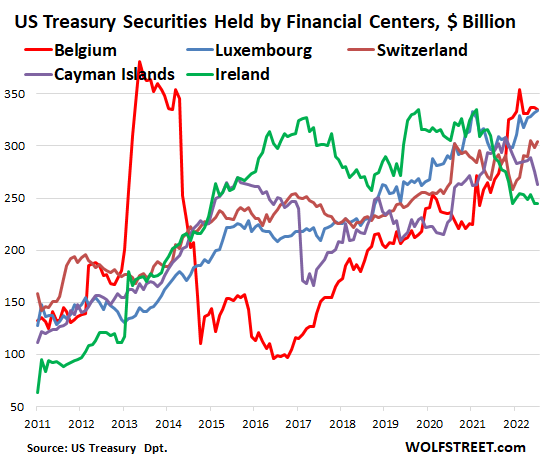
Other top foreign holders:
Canada’s holdings rose to a new record of $266 billion, up by 17.9% year-over-year:
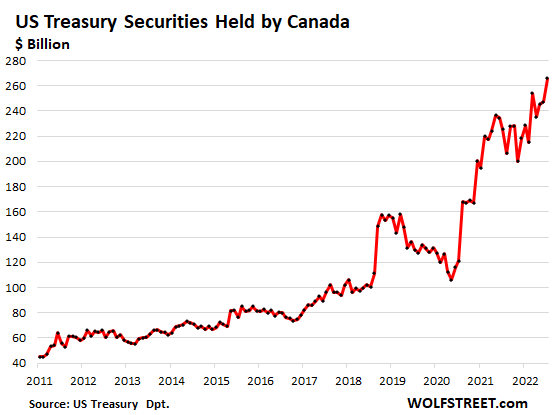
Taiwan’s holdings dipped for the month to $240 billion, but were up 4.7% year-over-year:
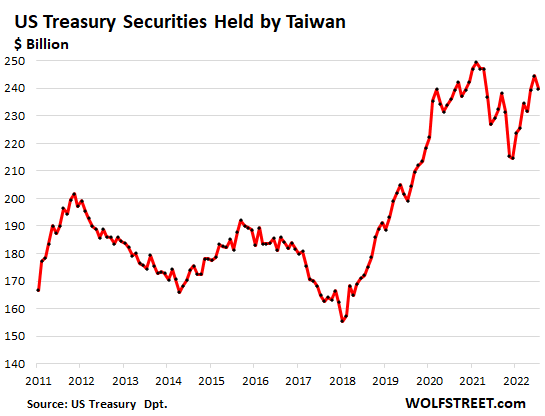
India’s holdings have been zigzagging higher for the entire period of the data going back to 2021, and for the last three months have been roughly flat at a record $238 billion, up by 17% year-over-year:
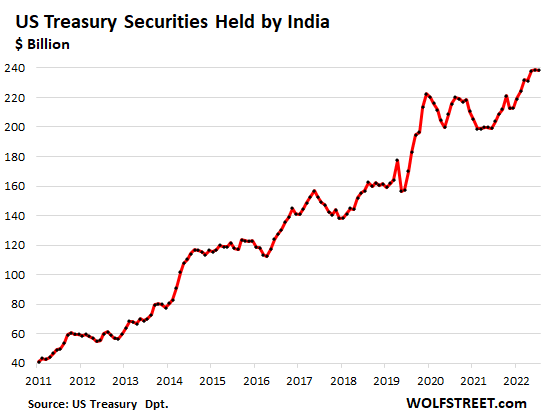
Brazil’s holdings, after dropping for years, bounced off the record low in January and in May rose to $230 billion, roughly unchanged from a year ago:
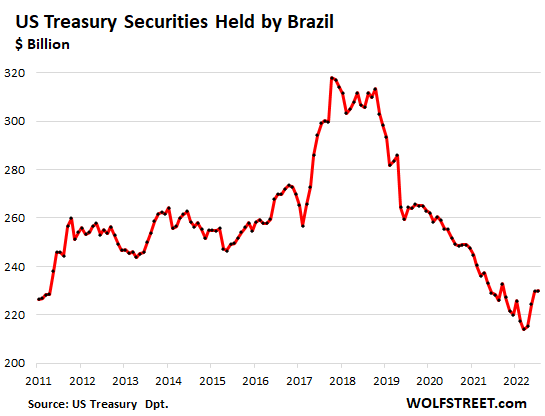
And there’s another thing that is important to keep our eyes on these days: US Dollar’s Status as Global Reserve Currency on Slow Long-Term Decline, but Not Going Down in a Straight Line
Enjoy reading WOLF STREET and want to support it? You can donate. I appreciate it immensely. Click on the beer and iced-tea mug to find out how:

Would you like to be notified via email when WOLF STREET publishes a new article? Sign up here.
![]()
[ad_2]
Source link
